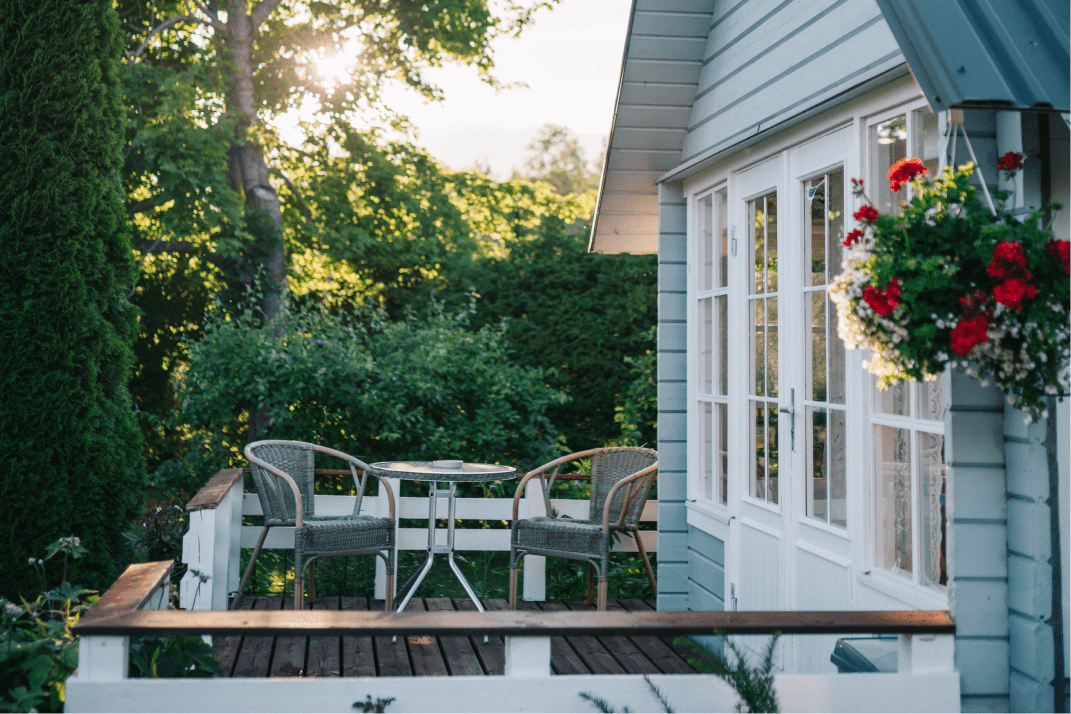


The sale-leaseback is becoming an increasingly popular option for homeowners looking to access their home's equity without moving. Find out how Truehold's Sale-Leaseback can help you live better at home.

Selling and leasing back your home is becoming an increasingly popular option for homeowners looking to access their home's equity without moving. Find out how Truehold can help you live better at home while enjoying the benefits of rental income. This approach offers two standard home transactions together: a home sale followed by a lease, providing continuity and stability without the need to relocate.
If you’re a long-time property owner, chances are you’re already familiar with the usual paths to unlocking home equity: HELOCs, home equity loans, reverse mortgages, and selling your home outright. If you’re new to the industry, consider researching how to utilize your home equity to build wealth and explore using home equity for retirement to gain a deeper understanding of this valuable asset. However, selling your home can be time-consuming and stressful, and may not be the right decision to meet your needs.
Fortunately, there’s a new option that many homeowners are turning to; the residential sell and stay transaction. This allows the homeowner to sell their property but continue living in it by making a rental payment under a lease payment agreement. This type of agreement allows you to take your hard-earned equity out of your home without actually having to leave it. Plus, unlike a home equity loan, HELOC, or reverse mortgage, when you sell and lease your home back you don’t have to take on additional debt. You can use your home’s value to do whatever you want: build your own business, pay for education, resolve open bills, hire at-home care, and more.
Exactly what is a sell and stay transaction and how does it work? Understanding a little more about it will help you learn how to evaluate a sell and stay transaction and determine if it’s a good option for you.
What is a leaseback? A leaseback is a financial arrangement where the seller of an asset leases it back from the buyer, allowing the seller to continue using the asset.
The sell and rent transaction was first popularized in the arena of commercial real estate. It provided business owners with an attractive option for eliminating debt on their property while simultaneously liquidating the equity. By selling your home and then renting it back, homeowners sell their property while remaining as tenants, providing immediate cash without needing to move.
Companies that chose this option could maintain their possession of a real estate asset without the burdens of ownership such as property taxes, property insurance, and essential repairs. It allowed business owners to free up capital to reinvest in the company. A sell then rent transaction involves selling a property and then leasing it back, ensuring continuous occupancy for the seller.
For example, a small manufacturing firm owns a factory that makes motorcycle parts. The demand for these parts has grown, and the company would like to purchase additional manufacturing equipment. If they were to sell the building, they’d free up the cash, but relocating would be prohibitively expensive. Securing a mortgage would be another option, but the proceeds of the loan wouldn’t yield enough money.
So instead, they choose the sale-leaseback process. They sell the building then lease it back for a negotiated term. With the cash flow now available, they can purchase the equipment needed to grow their business.
There are many advantages and disadvantages of selling your home and renting it back. Sell and stay programs are growing in popularity as more brokers and homeowners learn about these benefits, which include:
If you need or want ready cash, want to continue living in your home, and are open to the changes that come with a switch from homeowner to renter status, then you’re a potential candidate to sell and lease back your home. Common reasons for entering a sell-and-stay arrangement include:
If, for example, you want to sell your home and buy a new one, you may opt to negotiate with a potential buyer to include a short-term lease that allows them to close on the house and then lease it back to you for an agreed-upon period.
The lease term in a sell-and-stay program can vary, providing flexibility to the homeowner-turned-tenant. Monthly lease payments are agreed upon during the sell and stay process, allowing the seller to plan their finances. Opting for a long term lease can provide stability and predictability in living arrangements post-sale.
When you shop for a mortgage or loan, you’ll find fairly consistent standards among lenders based on credit score, debt load, employment history, and so on. A mortgage lender is taking a gamble that the property you’re buying is worth what you want to pay and that you’re a reliable candidate that can meet the loan obligations.
Sell and stay providers, however, don’t have to assess that level of risk. These providers are investors who buy your property outright based on appraised and market value. They work with you to ensure you can cover monthly rent payments as long as you’d like to stay in your home as a renter. If you choose to walk away from the home, a sell-and-stay provider can lease the house to another renter without losing money.
Since long-term sell and rent programs are fairly new to residential real estate, requirements vary between providers.
Our representatives connect with you one-on-one to help you decide if Truehold’s sell and stay transaction is right for you and discuss your overall financial picture.
Other than selling a home, a reverse mortgage is usually the first thing people think of when they’re looking for ways to free up accumulated equity. But while a reverse mortgage involves taking on new debt, a sell-and-stay transaction may offer a debt-free alternative.
Reverse mortgages are a loan. When you take out a reverse mortgage, your credit report reflects the debt. In the long run, this affects your ability to get approved for new credit cards, loans, or an increased credit limit.
When you opt for a sell-and-stay arrangement, you access your home equity upfront with no debt. You can continue to stay in your home as a renter and use the remaining cash however you’d like.
In addition to debt, reverse mortgages come with several upfront costs. With a reverse mortgage, borrowers will typically be subject to:
After the loan has been finalized, borrowers will be responsible for several recurring costs, including:
Truehold residents are not responsible for essential repairs, property insurance, or property tax. For these reasons, converting your home from a real property to a rental under a sell and rent transaction can alter your financial landscape.
Typically, a reverse mortgage only unlocks between 40 and 60% of your home’s property value. Truehold’s sell and rent transaction allows homeowners to access their home equity by selling their home, offering a pathway to financial flexibility.
Reverse mortgages are only available to adults above the age of 62. If you’re a younger homeowner hoping to unlock your home’s equity, you can either wait until you’re eligible for a reverse mortgage or consider another home equity unlock product.
Conventional mortgage financing options like home equity loans, HELOCs, and cash-out refinancing have no age requirements but often require borrowers to provide proof of income, high credit scores, and specific debt-to-income ratios—plus they result in more debt.
Reverse mortgages are just one way homeowners can access their home’s equity. Other home equity unlock products include cash-out refinancing, home equity lines of credit (HELOCs), and home equity loans.
Here’s how each of these conventional mortgage financing options compare to Truehold’s sell and stay transaction.
Cash-out refinancing allows homeowners who meet financial guidelines to access up to 80% of their home’s value. This may be a good option for property owners who have:
Eligible homeowners should be prepared to pay closing costs upfront and make monthly principal and interest payments on their cash-out refinancing loan.
Home equity lines of credit (HELOCs) provide credit, which is secured by the equity in your home. You’ll have a specific draw period during which you can access up to specific monthly limits, and then a set date when the repayment period begins.
You’ll usually need:
Eligible homeowners will be able to access up to 85% of their home’s equity through a HELOC.
HELOC interest rates are variable, and depending on the type of HELOC you choose, you may need to make minimum payments of interest or interest plus principal.
Unlike HELOCs, home equity loans are straightforward mortgage instruments with a set amount of money borrowed and a monthly repayment schedule that begins immediately. They tend to have lower interest rates than HELOCs.
Home equity loan requirements are the same as noted for HELOCs, above.
As with a HELOC, eligible homeowners will be able to access up to 85% of their home’s equity through a home equity loan.
Home equity loans have fixed interest rates, and some impose a prepayment penalty. This means that if your financial situation changes and you’d like to pay off the loan quickly, you’ll have to pay an extra fee.
Rates for both home equity loans and HELOCs are on the rise in connection with rising inflation.3Truehold, on the other hand, offers a better alternative by allowing homeowners to access more equity upfront in cash. To understand the advantages of Truehold over traditional home equity loans, including the amount of equity you can obtain and associated fees, explore our sell and stay transaction and home equity calculator.
When signing a sell and stay transaction on your home, there are several contractual and tax considerations to take into account. That said, this program consists of pairing two separate legal contracts. You’ll sign:
With Truehold’s sell and rent transaction, you’ll receive the contractual right to continue renting your home.
The conversion of your real property to cash and the switch of your status from a homeowner to a renter can have several tax implications based on the value of your home, your state and local regulations, and your filing status. These may include:
Plus the most important change of all: you’ll no longer have to pay property tax.
Consider speaking with a tax or financial advisor before finalizing your decision to ensure that you’re well-educated on your unique tax situation.
Equity grows slowly as you pay off your mortgage or by an increase in your home’s market value.
At the time of the sell and stay lease closing, the equity that has built up while you’ve owned your home is converted fully to profit. A home sale is the only way to unlock all of your home equity.
Once you sell your home and lease it back, you are switching from an owner to a renter, and you will no longer be making monthly payments or property investments that contribute to building equity. However, you will be able to unlock your home’s current equity and convert it into cash.
Our sell-and-stay transaction is not a debt product, which means homeowners who choose this option will avoid fees and penalties typical of other home equity unlock products. It is important to note that after the home sale, you must comply with the terms of your lease to continue living in the home. This includes making timely payments on your rent for your minimum lease term, ensuring you can enjoy the stability of your home without the financial burden of ownership.
The best way to find out if Truehold is a good fit for you is to reach out to us! Fill out the form below to request a no-obligation home offer. Alternatively, you may get in touch with a Truehold representative directly at (866) 523-3541 or via email at hello@truehold.com.
Chat with a real person & get an offer for your home within 48 hours.
Call (314) 353-9757